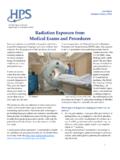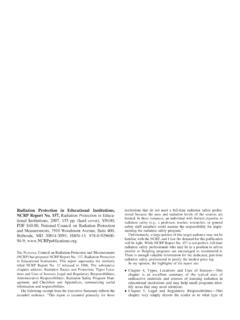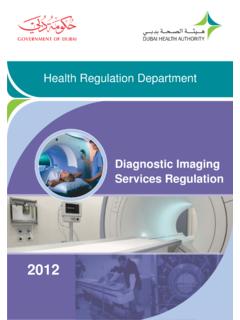Transcription of Components of Preparedness - Nuclear medicine
1 NMTCB Components of Preparedness 1 Components of Preparedness Domain I: radiation Physics & Detection 7% Domain II: radiation safety & Regulations 13% Domain III: Pharmaceutical & Radiopharmaceutical Agents 25% Domain IV: Instrument Operations & Quality Control 15% Domain V: Clinical Procedures 40% The NMTCB Components of Preparedness provide a description of the concepts, tasks, knowledge, and skills an individual needs to successfully understand and perform the necessary duties for an entry-level Nuclear medicine technologist. Components of Preparedness statements are published by NMTCB to assist students, program directors, and item writers. Each task is keyed to the 2017 Job Task Analysis Survey published by the NMTCB, which is the basis for the NMTCB Nuclear medicine exam. The NMTCB Components of Preparedness document was updated by NMT subject matter experts through a rigorous job practice analysis study and validated by NMT professionals working in the field through an extensive survey instrument.
2 The entry level NMT tasks and the knowledge needed to perform such tasks are extensively researched and grouped into the following functional content areas: Domain I: radiation Physics and Detection A Physical properties 1 Radioactive materials a. Modes of decay i. Gamma emitters ii. Beta emitters iii. Alpha emitters iv. Positron emitters 2 X-ray production a. Bremsstrahlung b. Characteristic x-ray B Measurement of radioactivity and decay calculations C Interactions of radiation with matter D radiation detector types and basic principles E Counting statistics NMTCB Components of Preparedness 2 Domain II: radiation safety and Regulations A Biological effects of radiation exposure B protection techniques and calculations 1 Time 2 Distance (inverse square law) 3 Shielding (shielding equations) C Monitoring protocols and requirements ( , timing and frequency) 1 radiation surveys (area monitoring) including: a.
3 Survey meters and well counters b. Choice of radiation detection devices ( , Geiger Counters, sodium iodide detectors) c. Frequency and limits of wipe surveys 2 Personal monitoring devices 3 Personal protective equipment ( , lab coat, gloves, syringe shields) 4 Effective dose equivalent limits for: a. radiation workers b. Pregnant radiation workers c. General public D Practice and adhere to ALARA E Nuclear Regulatory Commission (NRC) 1 Posting warning and informational signs delineating restricted and unrestricted areas 2 Surveying, inspecting and inventorying radioactive materials 3 Responding to adverse events a. Trigger levels and monitoring methods b. radiation exposure c. radiation spills d. protection during adverse events e. Personnel, patient and/or public decontamination f. Area/equipment decontamination 4 Adhere to radioactive waste storage requirements 5 Dispose of radioactive materials ( , liquids, solids, gasses, contaminated materials) 6 Identify recordable and reportable events 7 Maintain records as required for: a.
4 Receipt, storage and disposal of radioactive materials b. radiation monitoring and reporting c. Equipment calibration and maintenance d. Staff, patient, occupational and public exposure e. Nuclear medicine diagnostic and therapeutic procedures F Department of Transportation (DOT) - radiopharmaceutical transport 1 Use of shielding containers 2 Labeling requirements ( , transportation index, name, concentration, expiration date/time, total activity, assay date/time) NMTCB Components of Preparedness 3 3 Package monitoring/receiving/returning G Environmental protection Agency (EPA) H Occupational safety and Health Administration (OSHA) I Health and Human Services (HHS)/Health Insurance Portability and Accountability Act (HIPAA) 1 Protecting patient rights and privacy 2 Maintaining patient records 3 Releasing information to authorized parties J Knowledge of institutional and departmental accreditation organizations Domain III.
5 Pharmaceutical and Radiopharmaceutical Agents A Elute radionuclide generator, perform and evaluate quality control tests 1 Types of generators ( , 99 Mo/99mTc, 82Sr/Rb82, etc.,) a. Elution b. Generator yield volume and activity c. Quality control procedures i. 99Mo/99mTc (99Mo breakthrough and Al +3 content) ii. 82Sr/82Rb (measured activity and levels of 82Sr& 85Sr) 2 Dose calibrator operation / units of radioactivity B Prepare radiopharmaceutical kits , perform quality control, and evaluate results 1 Radiopharmaceutical kits a. Preparation techniques including particle size and number b. Activity and volume limitations c. Activity calculations 2 Radiopharmaceutical quality control a. Visual inspection - color and clarity b. Radiochemical purity 3 Labeling kits 4 Storage of kits before and after reconstitution C Understand the characteristics ( , mechanism of localization), indications, contraindications and administration of diagnostic radiopharmaceuticals 1 Tc99m labeled radiopharmaceuticals a.
6 Tc99m sodium pertechnetate b. Tc99m oxidronate/HDP c. Tc99m medronate/MDP d. Tc99m pentetate/DTPA e. Tc99m macroaggregated albumin/MAA f. Tc99m sulfur colloid g. Tc99m disofenin/mebrofenin (Choletec ) h. Tc99m mertiatide/MAG3 i. Tc99m pyrophosphate/PYP j. Tc99m sestamibi/MIBI (Cardiolite ) NMTCB Components of Preparedness 4 k. Tc99m tetrofosmin (Myoview ) l. Tc99m succimer/DMSA m. Tc99m exametazime/HMPAO (Ceretec ) n. Tc99m bicisate/ECD (Neurolite ) o. Tc99m labeled RBCs p. Tc99m HMPAO tagged WBCs q. Tc99m tilmanocept (Lymphoseek ) 2 Iodine labeled radiopharmaceuticals a. I-123 sodium iodide b. I-131 sodium iodide c. I-123 MIBG d. I-131 MIBG e. I-123 Ioflupane (DaTscan ) 3 Indium labeled radiopharmaceuticals a. In-111 Pentetate (DTPA) b. In-111 chloride c. In-111 oxine labeled WBCs d. In-111 pentetreotide (Octreoscan ) 4 Miscellaneous diagnostic radiopharmaceuticals a.
7 Tl201 thallous chloride b. Ga67 gallium citrate c. Xe133 gas 5 Positron Emission Tomography a. F-18 FDG b. F-18 Florbetaben (Neuraceq ) c. F-18 Florbetapir (Amyvid ) d. F-18 Flutemetamol (Vizamyl ) e. F-18 Sodium Fluoride (NaF) f. Rb82 chloride g. N13 ammonia h. Ga-68 Dotatate D Understand the characteristics ( , mechanism of localization), indications, contraindications and administration of therapeutic radiopharmaceuticals 1 Sr89 chloride (Metastron ) 2 Sm153 EDTMP lexidronam (Quadramet ) 3 I-131 sodium iodide 4 Y90 ibritumomab tiuxetan (Zevalin ) 5 Y90 microspheres (SIR-Spheres , TheraSphere ) 6 Ra223 Radium dichloride (Xofigo ) 7 I-125 Seeds E Understand the indications, contraindications, and administration of interventional and adjunct pharmaceutical agents used in conjunction with Nuclear medicine procedures NMTCB Components of Preparedness 5 1 dipyridamole (Persantine ) 2 adenosine 3 dobutamine 4 aminophylline 5 regadenoson (Lexiscan ) 6 captopril 7 enaloprilat 8 furosemide (Lasix )
8 9 insulin 10 acetazolamide 11 cholecystokinen/sincalide/CCK 12 morphine 13 cimetidine/ranitidine/famotidine 14 ACD solution 15 heparin 16 contrast media (oral and IV) 17 Lugol's solution/SSKI 18 Thyroid Stimulating Hormone (TSH) 19 Lidocaine 20 Lidocaine (EMLA) cream 21 atropine 22 recombinant human TSH (Thyrogen ) F Label blood Components with radiopharmaceutical according to protocol 1 Labeling procedures a. Required lab equipment and supplies b. Anticoagulants and other additives c. Chemical reactions d. Cell washing e. Required radiopharmaceuticals f. Method: invivo or invitro 2 Calculation of labeling efficiency and administered dosage 3 Reinjection patient and sample verification G Understand the routes of administration 1 Administration modes 2 Administration techniques ( , bolus, venipuncture, IV) H Prepare and administer non-radioactive agents 1 Follow aseptic technique 2 Adverse side-effects and treatment 3 Antidote medications 4 Interventional pharmaceuticals 5 Non-radioactive agents ( , ACD solution, heparin, contrast media, TSH, atropine, etc.)
9 ,) NMTCB Components of Preparedness 6 Domain IV: Instrument Operations and Quality Control A Non-imaging equipment, Components and operation 1 Perform and evaluate quality control on well counters and probes a. Calibrate and perform quality control on the sodium iodide scintillation detector b. Conduct a gamma ray spectra and pulse height analysis c. Apply formulas ( , energy resolution, sensitivity, Chi-square statistics, etc.,) 2 Determine operational status of survey meter a. Survey meter operations and Components b. Survey meter quality control 3 Perform and evaluate dose calibrator constancy, accuracy, linearity, and geometry tests B Imaging equipment, Components , and operation 1 Gamma Camera quality control a. Uniformity b. Spatial resolution and linearity c. Visual image quality d. Phantoms e. Artifacts f. Assess system sensitivity g. Pulse height analysis 2 SPECT and SPECT/CT imaging system a.
10 Attenuation correction b. SPECT camera quality control i. Center of rotation ii. Field uniformity requirements iii. Pixel calibration iv. 3-D uniformity and resolution ( , Jaczak phantom) v. Artifacts 3 PET and PET/CT imaging systems a. Application of attenuation corrections b. PET quality control ( , daily blank scan, normalization scan, 2-D/3-D well counter, artifacts, etc.) 4 CT imaging systems a. Co-registration of images b. CT quality control ( , contrast and spatial resolution, noise, uniformity, artifacts, etc.,) 5 Computer equipment ( , monitors, matrix sizes, printers, etc.,) 6 Networking and information systems ( , PACS and RIS ) C Auxiliary equipment 1 Laboratory equipment ( , pipette, fume hoods) NMTCB Components of Preparedness 7 2 Patient care equipment a. Intravenous infusion pump b. ECG monitor c. Pulse oximeter d. Defibrillator e.



